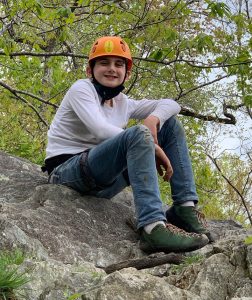
Flexibility is usually described as a positive trait in children. They might be able to do party tricks like bend their pinky backwards or always hit a split in gymnastics. But, if those skills come with chronic pain, your child could be living with a disability without even knowing it.
Ehlers-Danlos syndrome (or syndromes) (EDS)—which affects the range of mobility in the joints—is often underdiagnosed in children, leaving many navigating multiple specialists and chronic pain for years— sometimes even into adulthood.
Yet with the ebb and flow of symptoms, it’s a condition that can be misunderstood by peers—leading many to wonder, “Is it even real?” Children with invisible disabilities face the same questions every day.
Originally published for Invisible Disabilities Association’s Invisible Disabilities Week, Oct. 16-22, we revisit our chat with local teens and their families about what it’s like to experience a disability the world cannot always see for Rare Disease Day, on Feb. 28.
What is EDS?
Ehlers-Danlos Syndrome (EDS) has three main types, but the most common is hypermobile EDS (hEDS) in which there is a greater range of mobility in the joints.
Dislocations, abnormal skin issues related to weakened connective tissue—stretch marks, abnormal wound healing and scarring—and loose and sensitive skin, are all typical, says Dr. Mahim Jain, co-director of the connective tissue multi-disciplinary clinic at Kennedy Krieger Institute.
Without strong connections, “ultimately it leads to a lot of instability in the body, which can cause all sorts of osteopathic, orthopedic and muscular dysfunctions,” adds Jennifer Berman, of Pikesville, who co-founder of the Ehlers-Danlos Research Foundation with Dr. Alissa Zingman, of Silver Spring.
Sometimes injuries can occur even just getting bumped hard enough in the hallway on the way to class.
Because connective tissue disorders affect all parts of the body, it’s often tricky to recognize the bigger picture— unless you know what to look for—which is why many patients, especially children, can go decades without a diagnosis.
‘It’s Just Growing Pains’
Ren Marrill, 16, first noticed symptoms around age 7, but doctors didn’t start to suspect anything until age 11 when a sprained ankle turned into complex regional pain syndrome.

“I was getting a lot of pain in my ankles and back and, you know, like any other person I went to my primary care doctor—my pediatrician—and he said, ‘oh, it’s just growing pains.’ Yeah, it really wasn’t,” Ren says.
Because the criteria for determining joint flexibility starts in the teenage years, it can be hard to diagnose children, but if the pain persists and interferes with daily activities, likely it’s EDS, Jain says.
Ren was finally diagnosed with EDS a little over a year ago.
Others have had similar stories with hEDS. Zachary Kushner, 15, was diagnosed in 2021, nine years after first noticing symptoms of small fiber neuropathy and pain. Sixteen-year-old Andy, of New Market, received a diagnosis in 2021 after 8 years of symptoms.
Both were treated by Dr. Jain.
Andy recalls they got injured a lot more than their fellow dancers but didn’t know why. There was never a cause from doctors. “They would just give individual diagnoses for each acute problem,” Andy says.
The onset of EDS can be gradual or more sudden, as in the case of a physical trauma, Jain adds.
That’s what happened to Zach. The Hyattsville teen first started developing health issues after an allergic reaction at age 5. First came the neuropathy pain and then concussions from small incidents that wouldn’t normally concuss—since he was more prone to these injuries with EDS.
His doctors prioritized treating his acute concussions rather than trying to piece together a connection with other developing symptoms.
When it comes to diagnosing EDS, doctors also tend to more often recognize the symptoms of two of its most common comorbidities—the dizziness associated with POTS (a form of dysautonomia) or the characteristic rashes of mass cell activation syndrome, Jain says.
Underdiagnosed, Not Rare
Though most types of EDS are “rare to ultra-rare,” hEDS is not. Experts say prevalence figures are underestimates based on underdiagnoses and misdiagnoses, which is important for healthcare professionals to know because common conditions are given more priority and resources.
“For too many in our community, this is not an imaginary state; it is a lived experience (Halverson et al., 2021),” notes the Ehlers Danlos Society.
A lack of information on the disorder has led many patients to do their own research—including a research team of students with EDS who might have identified a gene mutation associated with hEDS at the Norris Lab in South Carolina.
Though the genetic link is not definitive, it’s common to see hEDS run in families. Some EDS patients, such as Zach’s mother Debbie—who is managing director at the research foundation—found out later in life.

and hopes to study medicine or law. | Provided Photo
Debbie Kushner recalls finding out her pain was not regular when her question, “You know like when you run down stairs and every step just hurts your body?” was met with shock.
If you have pain as your baseline, you might think everyone else does, too.
“For the longest time, until I was 11, I had no idea what was normal,” Ren says. “I played competitive soccer, and I always thought I was a wimp because I ran a lot slower than the other kids, and I was in a lot of pain.”
Andy says there’s a common phrase in the medical community that trains doctors not to ignore commonplace causes in favor of more unique conditions. The problem: they tend to assume the more common “horse” over the unusual “zebra.”
The EDS community has reconfigured the phrase: “Well, sometimes it is a zebra, and no two stripes are same,” Andy says.
Life as a Zebra

Living with EDS is a challenge, but there are many accommodations both at home and in the classroom that can help children better navigate daily life.
At school, Andy reduces stress on their back with digital book options, and teachers provide extended time on work and flexible seating so they can get up and move around as needed.
Ren used to wake up with more dislocated joints, but strategic placement of pillows and blankets helps.
Jain also recommends using good health practices — going to bed at a regular time, good nutrition and hygiene can keep body working smoothly.
Common treatments that help with EDS include regular physical therapy, pain medications for symptomatic relief and mental health services, he says.
And one of the most important things is being active.
Some might be surprised to learn what you can and can’t do with EDS. Dr. Kristen Kouvel, physical therapist at Children’s Hospital of Philadelphia, has worked with EDS patients for 10 years. Being active when young lessens risk for comorbidities, she says.
When Andy stopped dancing in prep for a hip surgery, they noticed an immediate difference. Though 15 or more hours per week was too much, having some dance alongside PT provides the best result.

Many kids and teens with EDS have active hobbies, too. Zach still continues with sports such as rock climbing and swimming, and though Berman’s daughter Abby (who also has symptoms of EDS) can’t participate in gym class, horseback riding is a favorite.
It’s not as scary as it might seem. It’s scarier not knowing what you have.,” Zach says. “There are more things you can do once you know.”
Even with appropriate treatments, there’s no easy fix that prevents all the bad days. But Ren found local and international support groups, and even a close childhood friend who was later diagnosed with EDS.
“It’s helpful knowing there are so many other teens like you out there,” Ren says.







